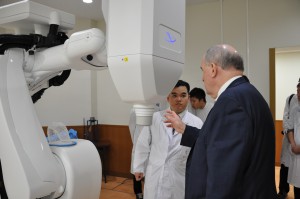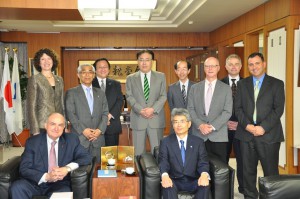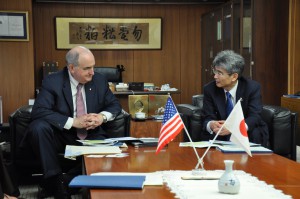Trains, exchange and harmony in Osaka
“Live locally, grow globally.”
One might expect to see that on a bumper sticker back home in Bloomington, not emblazoned across the promotional materials for one of Japan’s oldest and most prestigious universities. Yet somehow seeing those words halfway across the globe actually wasn’t all that surprising, given the overall harmonious nature of the IU delegation’s visit to Osaka University Tuesday (beginning with a several-hour ride on Japan’s impressive, high-speed “bullet train”) and the strong similarities that exist between two partner institutions each striving to be among the world’s top research universities.
“I believe that a 21st century university must seek to continue to evolve by pursuing truth and creating harmonious diversity,” Osaka President Toshio Hirano told IU President Michael A. McRobbie during an afternoon meeting, in which the leaders of both institutions discussed their respective bold visions for greater global engagement — which they hope to achieve, in large part, by increasing study abroad opportunities for students, encouraging collaborative teaching and research efforts among faculty and nurturing internationally minded graduates.
Indeed, as IU and Osaka look to build upon an institution-wide agreement inked in 2012, there is much common ground between the two universities, beginning with a mutual interest in rejuvenating student exchanges between the U.S. and Japan and, more specifically, a shared emphasis on foreign language instruction at a time when many universities, especially those in the U.S., are scaling back resources in this area.
IU and Osaka University, which is located in the world’s seventh largest city in terms of economic scale and second largest urban area in Japan after Tokyo, share the mutual distinction of teaching the most foreign languages of any universities in their respective countries. IU provides instruction in 70 to 80 different languages per year, all housed within the university’s new School of Global and International Studies, while Osaka offers 25 modern languages as majors and many other ancient and modern languages as minors through the 90-year-old School of Foreign Studies.
The School of Foreign Studies officially became part of the university in 2007 and is the only such school among all of Japan’s comprehensive national universities. Among the languages offered at Osaka is Swahili, which is also taught at IU. Not only does IU teach Swahili, the university operates the Swahili Flagship Center, the only such program in the U.S.

IU President McRobbie talks with Iori Sumida, assistant professor in the Department of Radiation Oncology at Osaka University’s School of Medicine.
“IU is renowned among linguists in Japan. You are, in fact, one the meccas of linguistics,” said Akihiko Azuma, dean of Osaka’s School of Foreign Studies, who shared with members of the IU delegation his memories of time spent studying Bloomington. Azuma came to IU at the urging of one of his undergraduate mentors. “My undergraduate supervisor … he said that every linguist should go to Bloomington to study and read books, many of which were only available in Indiana,” Azuma said.
As IU and Osaka aim to capitalize on their shared expertise and interest in language instruction and area and cultural studies, they can look to a much different academic area for inspiration. Over the last several years, the two universities have developed a substantial relationship in medical physics. Since 2011, 14 Osaka faculty members and students have studied at IU, while five IU radiation oncology faculty have visited Osaka in consulting and teaching roles and to attend conferences on radiation oncology.
Still, even in this area, there is room for growing the partnership. One of the Osaka faculty members who spent time at IU, Masahiko Koizumi, a professor of radiation oncology, told members of the delegation that Osaka has excellent and increasingly sophisticated equipment for radiation therapy, housed in its School of Medicine, yet is in major need of more trained personnel, including medical physicists, to work alongside Osaka physicians and technologists. Koizumi said he hopes IU faculty members will visit Osaka in the future to share their ideas, continue their education and collaborate on research initiatives.

IU President McRobbie and Osaka University President Hirano, seated in front of members of IU’s delegation and Osaka University faculty and staff.
At the final meeting of the day, with Dean Azuma and representatives from Osaka’s School of Foreign Studies and its Graduate School of Language and Culture (the first graduate school in Japan that specializes in this field), both sides agreed to discuss a potential student exchange program focused on IU’s and Osaka’s rich resources in world languages including Japanese and African languages. They also will continue to explore faculty exchange and collaborative research in linguistics and language studies, as well as possibilities for a broader partnership between Osaka’s School of Foreign Studies and IU’s new School of Global and International Studies.
From Osaka, it was back on the bullet train, which runs at speeds of up to 350 km/hour and is renowned for its comfort, cleanliness and, most of all, efficiency. (A personal aside: For this longtime rider of the New Haven-to-New York City Metro North line, the bullet train was, quite simply, surreal in its serenity and smoothness.) The train, which runs alongside Japan’s beautiful Mt. Fuji, was an easy, peaceful and fitting mode of transportation on a day filled with harmonious discussion and harbingers of future IU connections with Japan’s top universities.
Tags: Akihiko Azuma, bullet train, Indiana University, IU, Japan, Michael A. McRobbie, Osaka University, School of Foreign Studies, School of Global and International Studies, School of Medicine, Swahili Flagship Center, Toshio Hirano
 Indiana University
Indiana University


